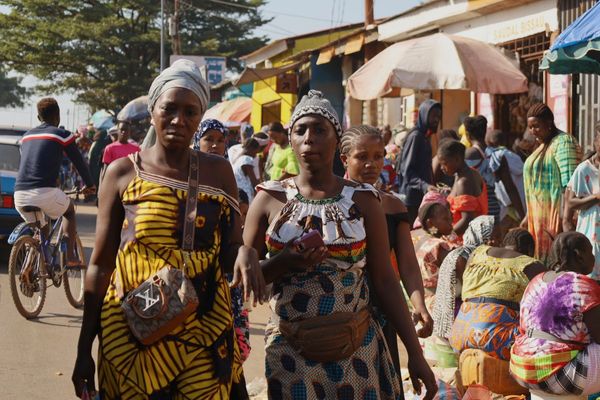“Telugu Vaari Atma Gauravam” (self respect of the Telugu people) — this was the clarion call of the Telugu Desam Party, founded by beloved Telugu superstar Nandamuri Taraka Rama Rao in March 1982, purportedly to counter the self-respect of the Telugu people being “bartered away in the streets of Delhi,” in his words.
Within nine months of floating the party, NTR, as he is popularly known, went on to sweep the 1983 Assembly elections in the then undivided Andhra Pradesh, bringing to an end 27 years of rule by the Congress. On January 9, 1983, N.T Rama Rao took over as the first non-Congress Chief Minister of undivided Andhra Pradesh.
The debutant TDP won a massive 201 out of a total 294 seats, riding on the popular Telugu pride sentiment, while the Congress was reduced to just 60 seats from the 175 it had won in the 1978 elections.
This landslide victory was a pivotal moment in regional politics that saw a ripple effect make its way to the Centre.
Reasons for birth of TDP
The Congress under former Prime Minister Indira Gandhi was the dominant political party in Andhra Pradesh during the time, ruling virtually unopposed since the State’s formation in 1953. Its electoral clout in the State was evident from the results of the 1972 State Assembly elections: the party won more than 52% of the votes cast and 219 seats out of 287.
However, a decade later, in the run-up to the 1983 elections, victory didn’t seem guaranteed for the Congress. There was growing discontent among sections of the State’s populace and a feeling that there was too much interference from Delhi in the State’s administration.
The central plank of Ms. Gandhi’s campaign in Andhra Pradesh was against regionalism, concentrating on the benefit of stable governments at the Centre and the State. But this failed to strike a chord among the public. This was especially following a particularly tumultuous time in the State, with four Chief Ministers in as many years between 1978 and 1982.
Mrs. Gandhi also refrained from addressing issues that concerned the people such as corruption and misrule during her campaign, and this became another sore point for the voters, according to archival reports from The Hindu. While warning against potential separatist tendencies, she batted for strong governments, but the people expected her to express support for a clean administration— which she didn’t do.
Another incident in February 1982 stoked the people’s ire against the Congress. Rajiv Gandhi visited the State and was welcomed by then Chief Minister T. Anjaiah at the Begumpet airport. But Mr. Gandhi humiliated the Chief Minister for the extravagant welcome and Mr. Anjaiah was left behind for the remainder of Mr. Gandhi’s trip that day, according to archived reports from The Hindu. Later that day, Mr. Anjaiah was called to Tirupati to join Mr. Gandhi. Adding insult to injury, Mr. Anjaiah was summoned to Delhi six days later and told to cut short the Assembly session.
Later that year, on September 24, Bhavanam Venkataram took over as the eighth Chief Minister of Andhra Pradesh; no concrete reason was given for his replacement.
Emergence of the TDP
Trouble was brewing elsewhere too, for the Congress.
Reportedly, NTR was a man who had little interest in a life in politics despite his stardom. Ramachandra Murthy Kondubhatla, in his book NTR — A Political Biography, an excerpt of which was recently published in The Hindu, describes NTR as a “very organised person” and says he was carefully working behind the scenes towards announcing his entry into State politics.
The author also claims NTR started following the political developments in Andhra Pradesh only after his daughter Bhuvaneswari married Chandrababu Naidu, the current TDP chief who was then a Minister in the 1981 Congress Cabinet in the State.
In a paper, K.C Suri notes that unlike other regional parties of the time, such as the Dravida Munnetra Kazhagam or Shiromani Akali Dal, the Telugu Desam Party did not emerge from a prolonged struggle or a sustained social movement. It did not have many leaders trained in an ideology or many who had live through politics or any party organisation. Its chief agenda was the safeguarding of “the political, economic, social, and cultural foundations of Telugu-speaking people.”
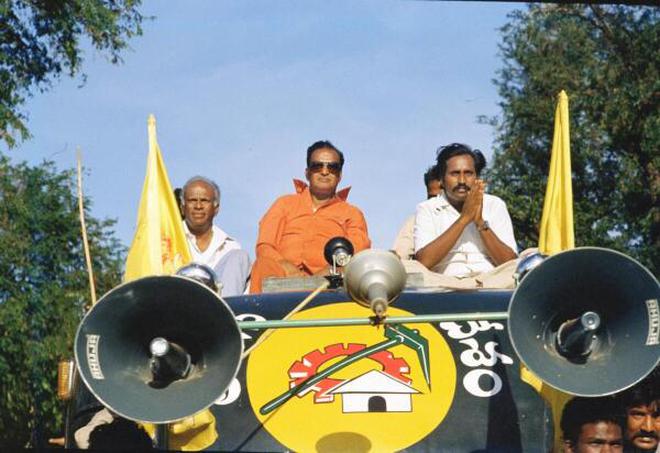
In a statement reported by The Hindu, Mr. Rama Rao said that his decision to enter public life was taken after representatives of his 900 fan clubs invited him to do so. Once he had etched out the basics for his new party, he chose March 29, 1982 to announce his decision. Interestingly, Mr. Kondubhatla in his book lists at least three NTR movies which were released on the date in different years and were hugely successful. He notes that the actor considered the date lucky.
At 2.30 p.m. on that “lucky” day, in a meeting at Hyderabad’s New MLA Quarters, NTR officially announced his decision to float his own party. He named it the Telugu Desam Party and asserted that his party would work for the self-respect of the Telugu people. “The people must decide who should lead them and leadership should never be imposed from the top,” NTR said during the party’s launch.
In a statement on the eve of the party’s first convention, in which a 31-point programme was outlined, NTR said that his responsibility “does not end with merely playing roles as an artiste. My inner voice repeatedly asked me to go among the people and I dedicate my life to see that the Telugu people regained their self-respect.”
Among other things, the TDP’s agenda included the diversion of State funds to rural development, free mid-day meals in schools, conversions of slums, work for the upliftment of Harijans, Girijans and backward classes and improved safety for women.
March to victory
The newly formed TDP had its work cut out. Although a charismatic and popular star, NTR had to counter the powerful influence of Mrs. Gandhi and Congress party stalwarts from Delhi, old hands at the political game.
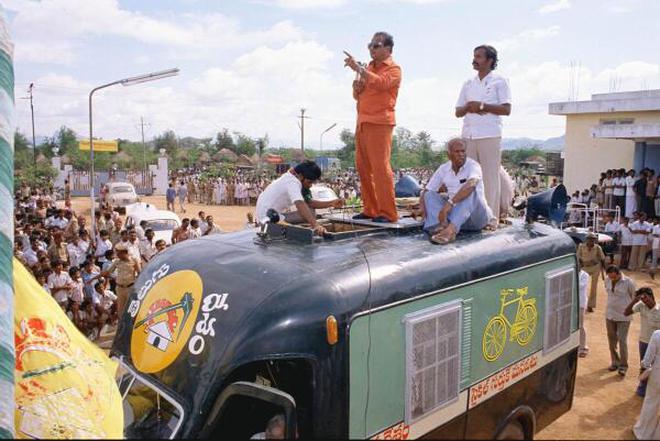
And NTR chose to do it sitting atop a modified Chevrolet van, driven mostly by his son Nandamuri Harikrishna. The set-up let him address groups whenever he saw them; it also provided him accommodation —he reportedly slept in the van. His tours began before dawn and ended after midnight. An article from The Hindu in 2018 recounts that NTR campaigned for nearly eight months in the van, which he named Chaithanya Ratham (the chariot of consciousness), logging 75,000 kms within the State. The campaign van was an idea he had apparently borrowed from then Tamil Nadu Chief Minister, M. G. Ramachandran— another popular actor-turned-politician.
His speeches, at first heavily anti-Congress(I), later mellowed and saw him addressing local issues. Non-political organisations such as the Rayalaseema Rythu Sangham, which campaigned for Krishna water for Rayalaseema, merged with the TDP, believing that it would reinforce their cause much better.
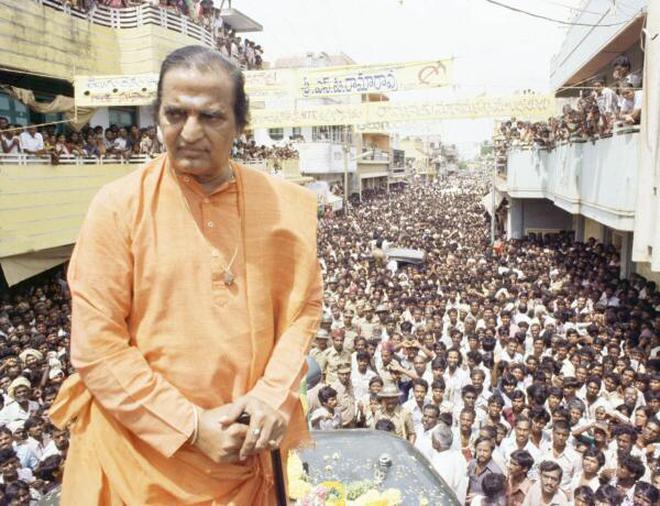
As the polls drew closer, NTR’s campaign paid off as he drew large crowds to his rallies. In an interview with The Hindu during his campaign, NTR said that it was not glamour that attracted these supporters. “Where is the glamour in the 60 year-old face that is tanned? The glamour was and is when I am seen on the screen.”
In comparison, Ms. Gandhi used a helicopter during her campaign to address various rallies to increase mobility, but this largely reduced her visibility to the people in villages along the roadways, as a contemporary report from The Hindu observed.
NTR had launched his campaign from the Chandragiri constituency, where his son-in-law Chandrababu Naidu was contesting for the Congress. Following the announcement of the polls, he filed his nomination from Gudivada Assembly seat and also from the pilgrim town of Tirupati, after much pressure from his followers.
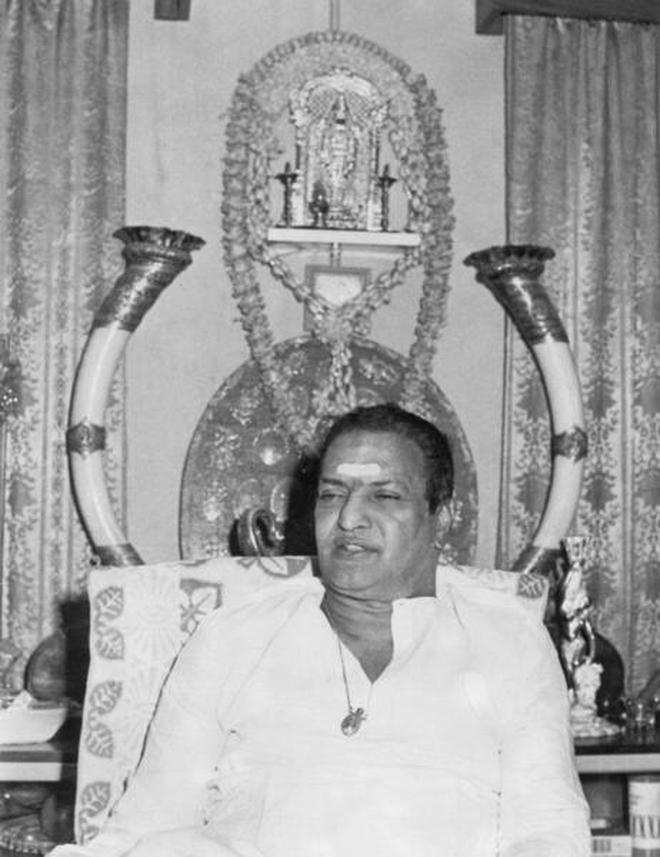
Congress was also increasingly aware of a looming NTR wave in the State. Tirupati, in particular, was considered a prestigious battle as Speaker of the Assembly A. Eswara Reddy was fielded against NTR. And to counter NTR’s influence, Ms. Gandhi scheduled the last poll speech of her electoral campaign there. Meanwhile, the then incumbent Chief Minister K. Vijayabhaskar Reddy contested from the Yemmiganur seat.
When the results were in, his party had won by an absolute majority, bagging 201 out of 294 seats. NTR himself won from both the constituencies he contested. Among Opposition parties, the Communist Party of India (Marxist) won five seats while the Communist Party of India won four. The Bharatiya Janata Party and the Janata Party won three seats and one seat respectively.
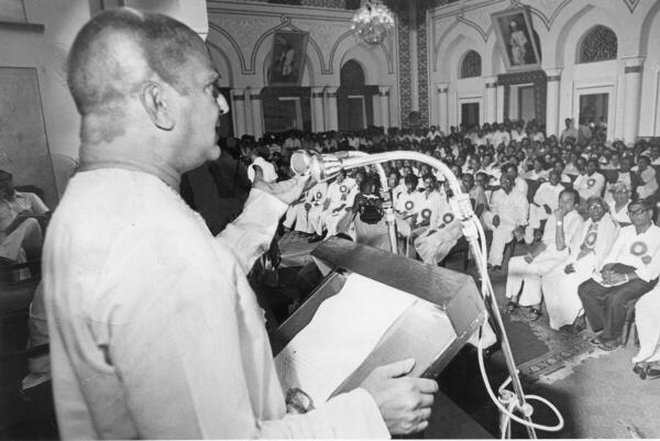
On January 9, 1983, N.T Rama Rao took the oath of office as the Chief Minister of Andhra Pradesh as a crowd of 1 lakh watched at the Lal Bahadur Stadium in Hyderabad. Nine cabinet ministers and five Ministers of State were also sworn in— the 15-member ministry was the smallest to assume office in the State since 1962.
Once it came to power, TDP followed through on several of its campaign promises, introducing several welfare measures in the State after forming the government. Notably, it implemented a scheme to provide rice at Rs. 2 per kg— one of its most popular poll promises.
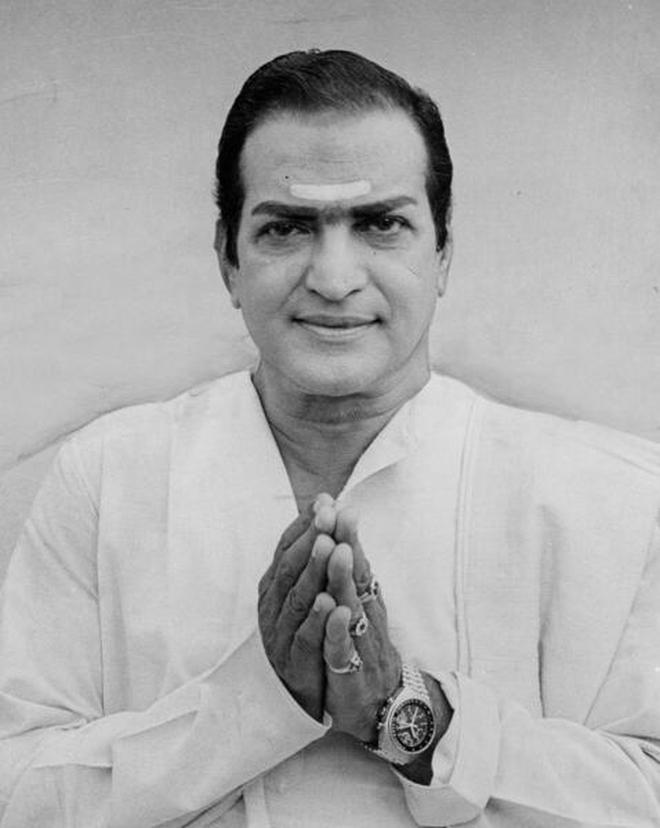
Post the poll results, Chandrababu Naidu jumped ship from the Congress to the TDP.
For a film star with several on-screen wins, NTR and TDP winning the 1983 elections was no less surreal. The victory ousted the Congress from power in the State. To date, the party has been unable to form a government there. The election was projected essentially as a contest between Ms. Gandhi’s centralism and NTR’s appeal to regional aspirations. The Congress largely banked on the popularity of the Prime Minister who was their major crowd puller. Andhra Pradesh went to polls in 1983 along with neighbouring Karnataka and Tripura. Ms. Gandhi had reportedly spent almost three weeks away from Delhi campaigning for her party in the two southern states. However, the results from all three States were a debacle for the Congress, a cause for great alarm for the party since the next parliamentary elections were due in 1985.
Post polls and road to 1985
In the months that followed the 1983 poll results in Andhra Pradesh, the Centre engaged in several maneouevres to try and topple the NTR government.
In July 1984, NTR left for the U.S. for a surgery. In August, Congress-appointed Governor Ram Lal dismissed the government, installing N. Bhaskara Rao as the new Chief Minister with the support of the Congress MLAs. Bhaskara Rao was the Finance Minister in the NTR Cabinet. Several Opposition leaders decried the move and criticised the Congress for toppling the government. Opposition parties also carried out protests in Delhi, calling the Centre’s high-handed move a murder of democracy.
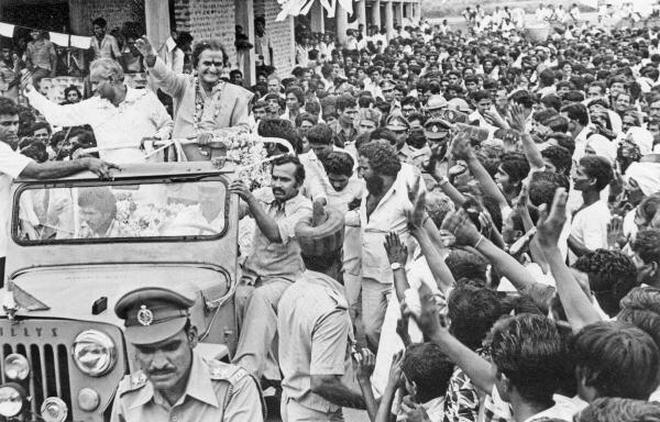
Following month-long protests in the State, Mr. Lal was eventually replaced as the Governor and NTR was reinstated as the Chief Minister in September 1984, after he effortlessly proved his majority in the House.
Mrs. Gandhi was assassinated in October 1984. In the general elections that followed, a wave of sympathy propelled Congress under Rajiv Gandhi to an absolute majority, with the party bagging more than 400 seats in the Lok Sabha. In the same election, the TDP under NTR won 30 seats in Andhra Pradesh, bucking the Congress juggernaut and became the second largest party in Parliament.
At TDP’s launch, Mr. Suri notes, many thought that it was an aberration or a transient phenomenon. It however, not only endured, but also became the single largest party in Opposition after the 1984 Lok Sabha elections, surpassing several other national parties.
Contribution to the National Front
An important contribution made by NTR is the forging of opposition unity in the form of the National Front.
The Congress(I) manoevres to dismiss NTR as Chief Minister in August 1984 earned his ire and brough him closer to national opposition parties like the Janata Party, Bharatiya Janata Party and the Left parties. Starting with Vijayawada, NTR held a series of Opposition conclaves, which resulted in the eventual formation of the National Front with him as the Chairman in 1988. This Opposition front came into being just in time for the 1989 Lok Sabha elections, and saw the rise of V.P Singh.
The 1989 Assembly elections in Andhra Pradesh saw the Congress bounce back to power winning 181 seats and the TDP winning only in 74. However, in the subsequent election in 1994, TDP won a massive 216 out of 294 seats, with NTR taking the State’s top post for a third term.
Notably, in his later years, NTR expressed disillusionment with the National Front, announcing his intention to launch a new national party, the Bharat Desam Party, in 1991. At time, TDP leader Raghuma Reddy is reported to have said, “Like in his movies, Rama Rao wants everything to happen in three hours.”
The end of the NTR era
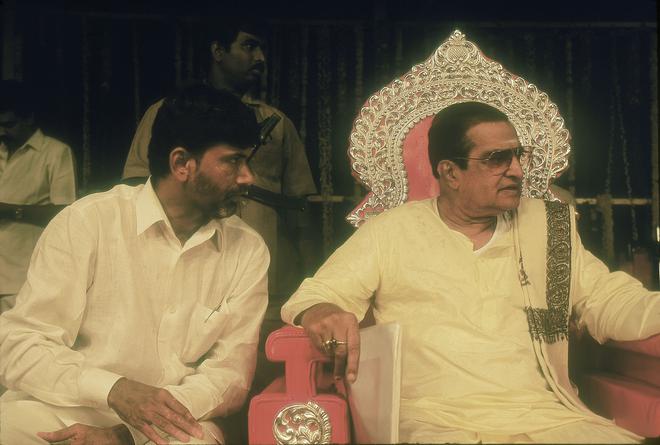
NTR’s third term was short lived, as a family crisis broke out in the party. NTR’s son-in-law Chandrababu Naidu revolted against him in 1995, protesting the growing interference of Lakshmi Parvathi, NTR’s wife. NTR had married Lakshmi Parvati in 1993, and reportedly sought to groom her as his successor.
This led to dissension within the TDP ranks. Mr. Naidu had the backing of NTR’s sons and claimed the support of a majority of MLAs. After a week of high drama, he eventually ousted NTR from power in an intra-party coup and took over the top post in September 1995, bringing the superstar-turned-leader’s colourful run to an abrupt end.
Although NTR vowed to make a comeback, it was not to be. On January 18, 1996, N.T Rama Rao passed away. Although Parvathi attempted to create her own TDP faction, the TDP legacy was eventually completely taken over by Chandrababu Naidu.





